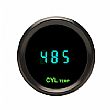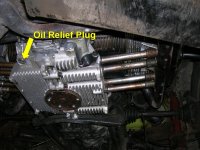I finished the engine upgrade for my '75 ST4 this past weekend. The new engine is a custom 1915cc VW type 1 engine. I've not pushed it too hard while breaking in, but I have to agree with Lyndon's comment on bigger VW engines - I won't be needing 1st or 2nd gear any longer!
Other things I did were a complete 12v conversion and rewiring as this was a 24V former military unit. Also added a new VDO oil temp gauge and sender (mounted in the front oil relief plug), modified a header exhaust and built exhaust pipes to route the muffler to the rear of the vehicle.
Cylinder head temperature is a concern since mine is a large bore engine and I retained the old-style fan shroud and oil cooler.One of the most critical additions I made is a Dakota Digital cylinder head temp gauge. Dakota's gauge is the only affordable CHT gauge/sender I could find that gives an accurate reading that's corrected for ambient temperature. Tested it in boiling water and it is spot on. I placed the thermocouple ring under the spark plug for the #3 cylinder because that's the jug that the oil cooler dumps most of the hot air on. Despite low operating oil temps (~175' F max), the #3 head can get awful hot when going up a grade in 4th gear, but the gauge tells you when you need to back off the throttle a bit or downshift.
Cheers - Paul
Other things I did were a complete 12v conversion and rewiring as this was a 24V former military unit. Also added a new VDO oil temp gauge and sender (mounted in the front oil relief plug), modified a header exhaust and built exhaust pipes to route the muffler to the rear of the vehicle.
Cylinder head temperature is a concern since mine is a large bore engine and I retained the old-style fan shroud and oil cooler.One of the most critical additions I made is a Dakota Digital cylinder head temp gauge. Dakota's gauge is the only affordable CHT gauge/sender I could find that gives an accurate reading that's corrected for ambient temperature. Tested it in boiling water and it is spot on. I placed the thermocouple ring under the spark plug for the #3 cylinder because that's the jug that the oil cooler dumps most of the hot air on. Despite low operating oil temps (~175' F max), the #3 head can get awful hot when going up a grade in 4th gear, but the gauge tells you when you need to back off the throttle a bit or downshift.
Cheers - Paul

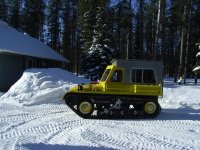


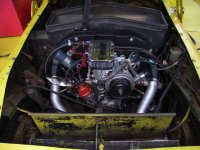
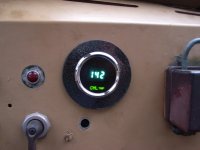
 ) I have put those little two barrels on all of my rails that I've built and love them. I've used them on everything from 1500's as well as warmed up 2.0 liter bus motors and they perform great. Their only weak spot is that the float tends to creep up and flood the engine when you are running it hard and there is a lot of boucing or vibration getting through the suspension to the carb, or under a steep climb with heavy throttle. I know we used to have a pretty simple fix that helped this problem out, but can't remember it off the top of my head. Next time I see my buddy whose specialty is high-perf V-dub engines I'll ask him what it was and get it posted up.
) I have put those little two barrels on all of my rails that I've built and love them. I've used them on everything from 1500's as well as warmed up 2.0 liter bus motors and they perform great. Their only weak spot is that the float tends to creep up and flood the engine when you are running it hard and there is a lot of boucing or vibration getting through the suspension to the carb, or under a steep climb with heavy throttle. I know we used to have a pretty simple fix that helped this problem out, but can't remember it off the top of my head. Next time I see my buddy whose specialty is high-perf V-dub engines I'll ask him what it was and get it posted up.
